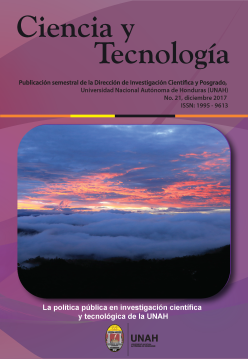Oral hygiene practices in schoolchildren of the Municipality of "San Ignacio de Loyola", Francisco Morazán
DOI:
https://doi.org/10.5377/rct.v0i20.5949Keywords:
oral health, school, oral hygiene, APS-buccal, dental brushingAbstract
Oral health is the interaction of all the economic, social, biological and cultural factors that contribute to healthier teeth in the individual. In addition, it is based on an attitude of prevention, nutrition, oral hygiene and physiological harmony that allows a better function with the digestive organs; for this it is imperative that children brush their teeth at least twice a day, beside using floss at least once a day to remove the bacterial plaque from the interdental spaces (work that the toothbrush can´t perform). For dental control effect, you must visit the dentist every six months at least. The objective of this study was to characterize the practices of oral hygiene in 1183 school children of the municipality of "San Ignacio de Loyola", Francisco Morazán. Method: An observational, descriptive, cross-sectional study on the oral hygiene practices of school children in the municipality of San Ignacio, belonging to the APS-Buccal Project carried out by the Faculty of Dentistry. Students, interns in social service and teachers made clinical observation and asked questions with the use of a poll. The ethical principles included in the Declaration of Helsinki were applied, for which informed consent was requested; explaining that dental evaluation is not subject to risk to their dignity, secrecy, physical security or life. Once all the information had been gathered from the instrument used; the following results were obtained: 13% of school children do not have a toothbrush, despite the efforts made in oral health. Only 40% of school children practice tooth brushing frequently. 94% do not use silk or floss daily. At 75%, fluoride has never been applied. 62% have never visited the dentist. 32% of school children do not exercise lingual brushing, which is a very appropriate action to reduce the bacterial load of the oral cavity, as well as to prevent halitosis or bad breath. Conclusions: The practices of oral hygiene are deficient, for this reason the APS-B model will be applied to the future, placing the school as a biopsychosocial person who will be provided with comprehensive care.
Downloads
1185
Downloads
Published
How to Cite
Issue
Section
License
© Revista Ciencia y Tecnología
Authors who publish in this journal accept the following conditions: In accordance with the legislation of copyright, Revista Ciencia y Tecnología, recognizes and respects the moral right of authors, as well as the ownership of the patrimonial right, which will be ceded to the magazine for its diffusion in open access in printed version and in digital format. By being part of multiple indexers, databases and reference systems, the articles published by Revista Ciencia y Tecnología will be visible and will be downloaded from these websites, indicating, in all cases, the authorship of the articles, the date of publication and the number of the journal to which they correspond.




